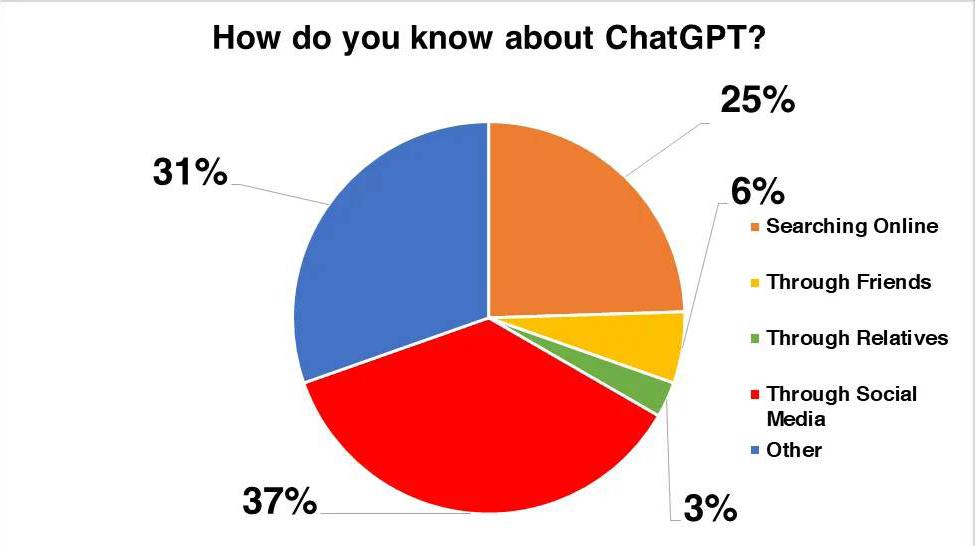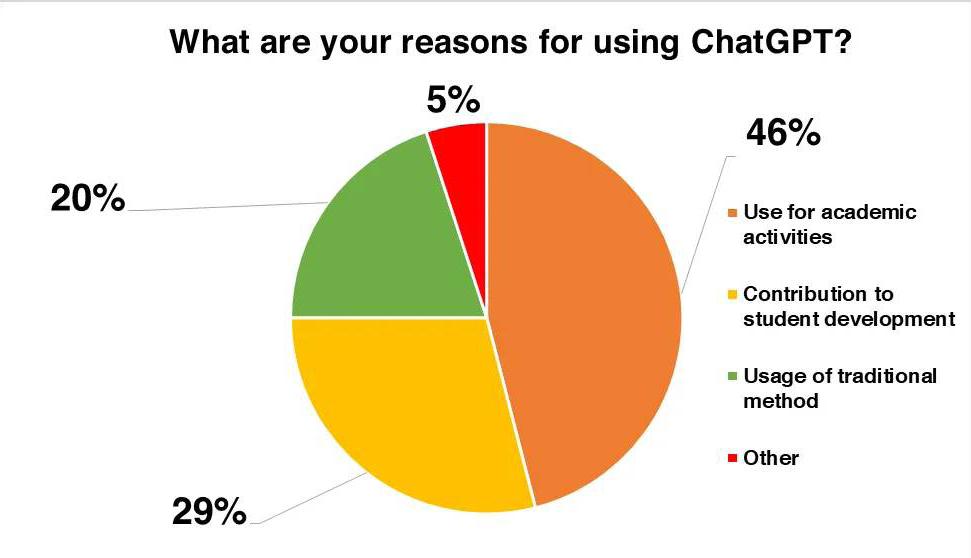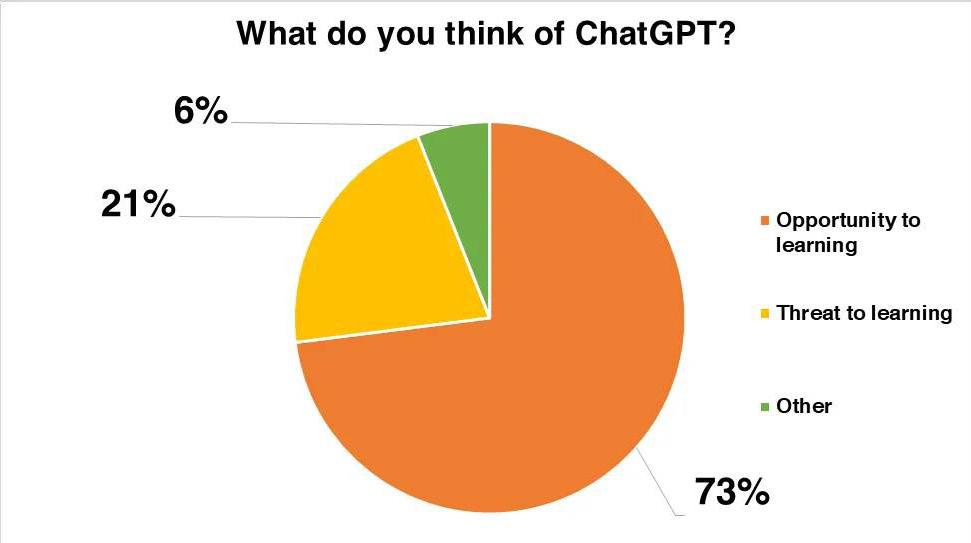
6 minute read
LEARNERS’ PERCEPTION, INTENTION, AWARENESS OF CHATGPT AT PBHS TECH RESEARCH:
By John Vincent M. Manatad
EEducational institutions have benefited from and faced obstacles because of the introduction and development of technologies like artificial intelligence. For higher educational institutions, artificial intelligence, such as OpenAI’s Chat Generative Pre-Trained Transformer (ChatGPT), has introduced new advantages, difficulties, and demands. In the Philippines alone, few reports have been made about how students see and plan to use ChatGPT especially in the public junior high schools. Hence, to understand the perception, intention, and awareness of ChatGPT among the learners at Ponciano Bernardo High School during the School Year 2022-2023, The Hillside Chronicle conducted an anonymous online closed-ended survey using Google Form which was answered by 150 learners from Grades 7 through 10. The results of the online survey were followed up using a semi-structured interview with ten (10) learners who were selected purposively and conveniently. The purposive sampling was based on the participants who have used ChatGPT at least once in their education. Meanwhile, the convenience aspect of the sampling sought to engage the learners who were willing and were relatively free. The results of the close-ended survey research are provided in Figures 1 to 3:
Advertisement
Findings from the survey questionnaire
Figure 2. Intention to use ChatGPT
Figures 1 and 2 show the results for the construct of perceptions and intentions to use, and the percentage of seventy-three (73%), as revealed in Figure 1, translates to learners being inclined to agree that ChatGPT is an “opportunity to learn,” indicating a strong agreement of respondents’ intentions to use ChatGPT for their academic activities, a total of forty six percent (46%), as shown in Figure 2. Figure 3 indicates where the learners got to know about ChatGPT. The respondents provided varied responses which most dominantly related to social media or thirty seven percent (37%). Others indicated that their relatives introduced them or three percent (3%).
Findings from the semi-structured interview
The Hillside Chronicle carefully studied the transcripts of the interview data in order to determine the qualitative element. The first question centered on the learners’ familiarity or understanding of ChatGPT. The results provided valuable information since they revealed how the spread of ChatGPT had affected learners’ education. Some responses are shown in Excerpt 1 and Excerpt 2. Even though there are several discussions on ChatGPT’s opportunities and threats, the respondents also voiced their worries. The learners’ answers favored the opportunities of ChatGPT to them. Excerpt 3 includes the answer.
Excerpt 1:
“
“
Well, I watch a lot on Youtube. I go to a lot of social media. Somewhere, somehow, I just come across the term. I think it’s okay. It’s cool. It’s very helpful but I won’t recommend using it since it’s lessening our values. It’s lessening our opportunities to learn and to work harder for something since it’s an AI that can do things almost everything faster than us. So, we will lose the value of taking the time to work hard for something.”
Excerpt 2:
There was this one time that I used it to ask for information. It can tell you all the questions you ask. It is not trustworthy. It gives ideas but that’s it. If students were to use it as basis for their topics, it is not recommendable because you won’t know if it’s true or not.”
Excerpt 3:
“
It is an AI that can make everything you ask it for, from essays to mathematical equations. Somewhat, because when I do not understand a problem, I tend to go to the site for help, and it usually explains it better than most. As a tool, it has some benefits but if you were to abuse it, you will never learn and will continuously depend on it which in turn, will result in no learning.”
Discussion, Conclusions, and Implications
The purpose of the anonymous online survey conducted by The Hillside Chronicle is to find out the perception and intentions of the use of ChatGPT by learners in Ponciano Bernardo High School. The Hillside Chronicle discusses the findings from the analyzed quantitative and qualitative data.
Regarding perceptions, most learners expressed their opinions of ChatGPT in favorable ways. Its value in fostering students’ growth and enhancing academic activities informed the use intents.
As a result, ChatGPT is pushing educational transformation and a shift away from conventional ways of instruction delivery. It is undeniable that students’ support for integrating ChatGPT into the educational system is modeled by their satisfaction with using new technologies, the improved results they bring using new technologies and the excellent user experience.
From the qualitative data, it is clear that social media has a positive impact on the learners. Evidently, as stated by the respondents, writing,
By Iya Beatriz C. Perez
mathematical, and information-seeking abilities had greatly increased.
The Hillside Chronicle aimed to investigate how students at Ponciano Bernardo High School perceived and intended to utilize ChatGPT.
The Hillside Chronicle was driven by the very small number of studies and the necessity to report from a specific setting via the perspective of students especially in public junior high schools in the Philippines.
Furthermore, The Hillside Chronicle found that the learners intended to use ChatGPT and supported its implementation in education because their use was made easier by their experience.
The findings also revealed that learners have a favorable opinion of ChatGPT because it produces good results.



Moreover, the results indicated that social media was the main source of students’ awareness of ChatGPT, and they were more aware of its opportunities than its threats.
Numerous implications for educational methods and future research may be drawn from this survey research.
Despite the fact that there were 150 participants, the quantitative data was insufficient to clearly link perceptions and intentions to utilize ChatGPT in learning.
The Hillside Chronicle suggests that other research might broaden their scope by using a larger sample size than theirs.
Additionally, utilizing ChatGPT as a tool, the findings serve as a platform for other institutions to examine the future paths of education.
Finally, in order to document the range and depth of worries concerning ChatGPT in education, The Hillside Chronicle suggests separate quantitative and qualitative investigations of the current issue that involve other constructs and demographic variables.
TECH REVIEW: Tiktok as new ‘Key Search’ concerns PBHS research manager
Many teenagers thought TikTok was just another social networking site for dancing videos and pop music when it first started in 2016.
However, TikTok is currently renowned for being a creative outlet and an increasingly available search engine for Generation Z after becoming widely famous in 2020.
In September 2022, the New York Times even proclaimed that “For Gen Z, TikTok is the New Search Engine.” “Nearly 40% of Generation Z prefer researching topics on TikTok over platforms such as Google,” the New York Times report read.
In that same month, however, Gelo Gonzalez in his report for “Rappler. com,” reported that “about 20% of TikTok’s search results, according to a US-based website run by journalists who monitor internet disinformation.”
According to Flor Abel Vilog, the school research manager and English teacher teaching research in Grade 10 at Ponciano Bernardo High School, Generation Z utilizes TikTok as a study tool because of its ease and convenience. “TikTok appeals to Gen Z since it does not demand a lot of attention, in my opinion, because of our extreme- ly internet-attuned upbringing and our reliance on instantly digestible media and information.,” Vilog said. “TikTok is a quick and easy method to get a lot of information on a variety of topics,” he added.
Anthony James Segui, a Grade 10 learner from section Mabini argued that he finds it appealing in many ways as when he searches on TikTok, a variety of comments from people with various viewpoints appear. “When you use Google to research anything, you often receive highly specific search results in articles, but your query may not actually be addressed,” Segui said. “On TikTok, you may choose what you want to listen to while researching different topics while hearing from actual people.”
Chad Mejarito of Grade 10 Del Pilar said he looks Google for news and TikTok for lifestyle advice. “Instead of learning from a random individual, I would prefer to do it from a reliable news source. However, I like to use TikTok to do searches for more aesthetic matters in my life, such as where I want to eat or where to purchase clothes,” Mejarito remarked.
Vilog said in addition to lifestyle advice, TikTok is an app that individuals use to learn about news. “I discover that a lot of individuals use TikTok as a medium to share information on political activism and movements. If they think that particular candidates win elections for a reason, or if they think that a candidate will be a good or awful governor, senator, or member of the house, they may make predictions,” he said.
Also, Segui explained because of its interactive features, TikTok is a helpful search engine. He asserted that TikTok is the most effective at bringing together viewers and producers among the major social media platforms. “You may always post a question in the comments on TikTok, making it interactive. A response to your query may then be included in a subsequent video made by the content creator. If you like, you may ask the same individual for follow-up information, which is thrilling,” Sequi said.
However, Vilog said compared to conventional search engines, TikTok might provide its less-experienced users with more false information. In addition to TikTok, Vilog advised Grade 10 learners to conduct their own research on reliable websites.
According to Vilog, the major problem with TikTok and the propagation of false information is that individuals frequently make claims about a variety of distinct individual issues and group them together under a single heading. Because of this, it is challenging to have a fruitful conversation regarding the material provided on TikTok. Vilog also said TikTok content frequently contains prejudices and personal beliefs.










